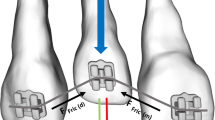Summary
The aim of this study was to measure in vivo the forces and moments acting therapeutically on the individual tooth in connection with the multiband technique. Securing and evaluating the planned in vivo measurements involves analysing the measuring accuracy of the system as a whole by means of corresponding in vitro investigations. Errors in determining the therapeutically effective force system may result from the electrical measurement of the mechanical quantities by the sensor system and from the fixing of the archwire in therapeutic position. The precision of this fixing is influenced by displacements induced by elasticities and mechanical tensions in the measuring system. Calibration test series have shown the sensor system to have a margin of error of less than 2%. The displacements influencing precision fixing of the archwire were determined by means of a laser position measuring system. For a maximum orthodontic force of 1.5N, they are 0.06 mm in the least favourable case. The resulting measuring accuracy was determined analytically or graphically, depending on the key parameters. Successful in vivo studies of the therapeutically applied force systems are to be expected on the basis of these results.
Zusammenfassung
Das Ziel dieser Arbeit ist die In-vivo-Messung der auf den einzelnen Zahn therapeutisch einwirkenden Kräfte und Momente bei der Multibandtechnik. Zur Absicherung und Bewertung der anstehenden In-vivo-Messungen ist eine Analyse der Meßgenauigkeit des Gesamtsystems durch entsprechende In-vitro-Untersuchungen durchzuführen. Mögliche Fehler bei der Bestimmung des therapeutisch wirksamen Kräftesystems ergeben sich bei der elektrischen Messung der mechanischen Größen durch das Sensorsystem sowie bei der Fixierung des Drahtbogens in der therapeutischen Position. Die Genauigkeit dieser Fixierung wird durch Verlagerungen beeinflußt, die durch Elastizitäten und mechanische Verspannungen des Meßsystems verursacht werden. In Kalibrierreihen konnte gezeigt werden, daß der Fehler des Sensorsystems unter 2% liegt. Die Verlagerungen, die die exakte Fixierung des Drahtbogens beeinflussen, wurden mit Hilfe eines laseroptischen Wegmeßsystems bestimmt. Sie betragen für eine maximale orthodontische Kraft von 1,5 N im ungünstigsten Fall 0,06 mm. Die resultierende Meßgenauigkeit wurde abhängig von den entscheidenden Parametern analytisch oder graphisch ermittelt. Auf der Basis dieser Ergebnisse sind erfolgreiche In-vivo-Studien zu den therapeutisch applizierten Kräftesystemen zu erwarten.
Similar content being viewed by others
References
Bourauel C, Drescher D, Thier M. An experimental apparatus for the simulation of three-dimensional movements in orthodontics. J Biomed Engng 1992;14:371–8.
Burstone CJ, Koenig HA. Force systems from an ideal arch. Am J Orthodont 1974;3:270–89.
DeFranco JC, Koenig HA, Burstone CJ. Three-dimensional large displacement analysis of orthodontic appliances. J Biomech 1976;9:793–801.
Friedrich D, Rau G, Diedrich P. Dreidimensionale Kraft-Momenten-Messung. Feinwerktechnik Mikrotechnik Mikroelektronik 1996;9:650.
Katona TR, Nasser HP, Hasan UA, Roberts WE. Stress analysis of bone modeling response to rat molar orthodontics. J Biomech 1995;28:27–38.
Koenig HA, Burstone CJ. Analysis of generalized curved beams for orthodontic applications. J Biomech 1974;7:429–35.
Koenig HA, Burstone CJ. Force systems from an ideal archlarge deflections considerations. Angle Orthodont 1989;59:11–6.
Koenig HA, Vanderby R, Solonche D, Burstone CJ. Force systems from orthodontic appliances: an analytical and experimental comparison. J Biomech Engng 1980;102:294–300.
Meyer R, Wehrbein H, Schneider B. Klinisch relevante Biomechanik. 4. Mitteilung. Die Prinzipien der Zweizahnphilosophie in der Straight-wire-Technik. Prakt Kieferorthop 1991;5:295–302.
Rosarius N, Friedrich D, Fuhrmann R, Rau G, Diedrich P. Concept and development of a measuring system for in vivo recording of orthodontically applied forces and torques in the multiband technique-Part I. J Orofac Orthop/Fortschr Kieferorthop 1996;57:298–305.
Shroff B, Lindauer SJ, Burstone CJ, Leiss JB. Segmented approach to simultaneous intrusion and space closure: biomechanics of the three-piece base arch appliance. Am J Orthodont Dentofac Orthop 1995;107:136–43.
Weiler W. Kalibrierung und Prüfung von Kraftmeßgeräten. In: Weiler W, ed. Handbuch der physikalisch-technischen Kraftmessung. Braunschweig-Wiesbaden: Wieweg, 1993:190–213.
Author information
Authors and Affiliations
Corresponding author
Additional information
This research is supported by the Deutsche Forschungsgemeinschaft (ref.: Di 595/1-2).
Part I of this article is published in J Orofac Orthop/Fortschr Kieferorthop 1996; 57:298–305.
Rights and permissions
About this article
Cite this article
Friedrich, D., Rosarius, N., Schwindke, P. et al. In vitro testing of a measuring system for in vivo recording of orthodontically applied forces and moments in the multiband technique. J Orofac Orthop/Fortschr Kieferorthop 59, 82–89 (1998). https://doi.org/10.1007/BF01340642
Received:
Accepted:
Issue Date:
DOI: https://doi.org/10.1007/BF01340642




